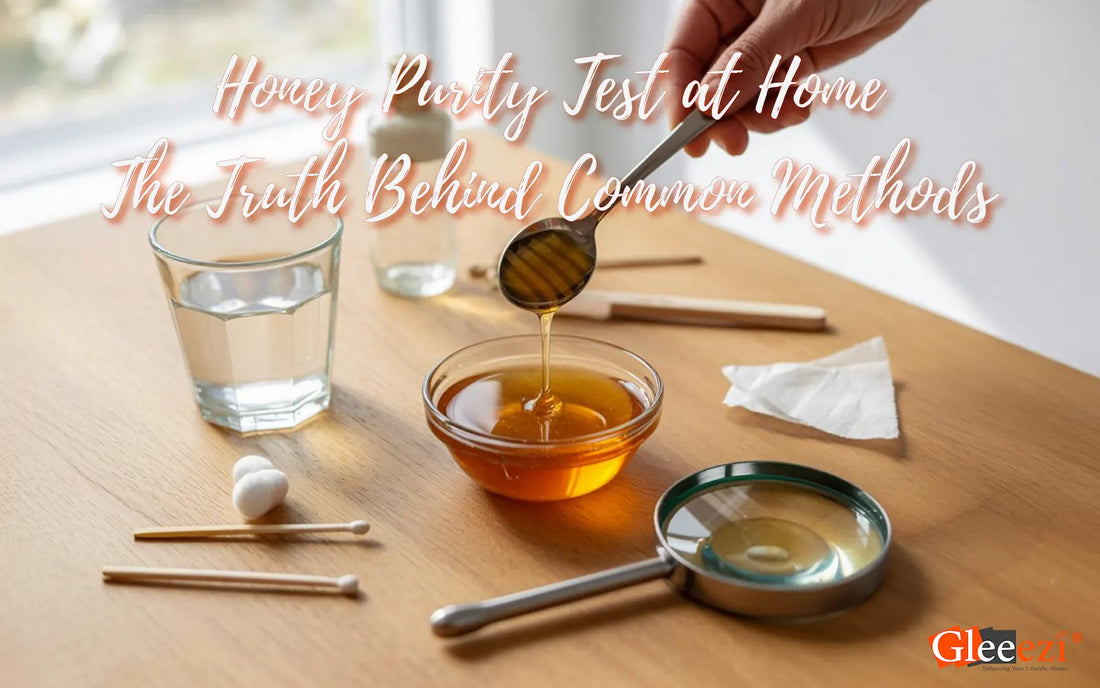
Honey Purity Test at Home – The Truth Behind Common Methods
Share
Honey Purity Test at Home has become a popular topic, but most common methods may not be as reliable as people think. In this blog, we uncover the truth behind these tests and explain what really works for checking honey purity.
Before we explore honey purity test methods at home, it’s important to first understand how the qualities of real honey vary depending on its type. This step is crucial because only by knowing the natural properties of pure honey can we accurately evaluate whether a testing method is reliable or not.
Honey can naturally be thick or thin depending on its type and the flowers it comes from. For example, clover and wildflower honey are usually thick, while some others are thin and runny. Both thick and thin honey can be pure. Most home tests for honey purity focus mainly on its thickness, but thickness alone does not determine purity. Different varieties of natural honey have different textures and moisture levels. Now, we will explore the truth behind various home methods used to test honey purity.
1.Water Test for Honey Purity – How Reliable Is It?
The water test is often used as a quick method for detecting pure honey, but it’s not always 100% reliable. Here’s why:
· If thick sugar syrup is added to honey, it can also sink to the bottom of the glass just like pure honey, giving a false impression of authenticity.
· Some floral honey varieties are naturally thin in texture. They dissolve quickly in water but can still be genuine and high-quality honey.
· Temperature plays a big role — honey stored in cooler conditions tends to thicken and sink, even if it contains impurities.
2.Thumb Test for Honey Purity – How Reliable Is It?
In this simple test, a small drop of honey is placed on a dry thumb. Pure honey, due to its natural thickness and stickiness, stays put and moves slowly. On the other hand, adulterated or high-moisture honey tends to spread or run off quickly.
However, the thumb test is not 100% reliable because:
· Thick sugar syrups like corn syrup also don’t spread easily, allowing fake honey to pass.
· Temperature affects consistency; cold honey thickens naturally, even if it’s adulterated.
· Some floral honeys, such as acacia or tupelo, are naturally thin and may fail this test despite being pure.
3.Flame Test for Honey Purity – How Reliable Is It?
In this test, you dip a matchstick or small wooden stick into honey and try to light it. Pure honey, having low moisture, allows the stick to catch fire easily. If the honey is mixed with water or other substances, lighting the stick becomes difficult or impossible.
However, the flame test is not fully accurate because:
· External moisture or humidity can also extinguish the flame.
· Artificially thickened honey may still let the stick burn, causing false results.
· This test only checks the honey’s surface, not its full composition.
4.Vinegar Test for Honey Purity- How Reliable Is It?
In this method, you mix a small amount of honey, water, and vinegar in a bowl. If the honey is adulterated with chalk or other additives, the mixture will produce foam or bubbles. Pure honey, however, will keep the mixture clear without foam.
But the vinegar test isn’t completely reliable because:
· Not all fake honey contains alkaline substances, so no foam doesn’t always mean purity.
· Sometimes pure honey can react lightly with vinegar, causing confusion.
· Incorrect amounts of vinegar or water can affect results.
· Foam can also form due to other chemicals or environmental factors.
5.Heat Test for Honey Purity – How Reliable Is It?
In this test, a small amount of honey is gently heated in a spoon or pan. Pure honey caramelizes slowly without producing bubbles. Adulterated honey or honey mixed with water or sugar syrup tends to bubble or foam quickly when heated.
However, the heat test isn’t completely reliable because:
· Some natural honeys may produce slight foam depending on their floral source.
· Ambient temperature and the honey’s starting temperature can affect results.
· Overheating honey can cause it to burn instead of caramelize, leading to confusion.
· Artificially thickened honeys sometimes pass this test due to additives that prevent foaming.
6.Tissue Paper Test for Honey Purity – How Reliable Is It?
In this test, a small drop of honey is placed on a piece of tissue paper. Pure honey does not soak into the paper, keeping it dry. Adulterated or watery honey absorbs quickly, making the tissue wet or soft.
However, this test isn’t fully reliable because:
· Some artificially thickened syrups don’t absorb, giving a false impression.
· Thin pure honey usually absorbs quickly into tissue paper.
· The quality and absorbency of the tissue paper can influence results.
· This test mainly indicates moisture content, not true honey purity.
How to Verify Honey Purity – Lab Testing is the Only Reliable Way
So, the question is: how can honey purity be accurately checked? The answer is that honey purity can only be verified through proper lab testing—there is no other foolproof method. You can try Gleeezi Honey, which is 100% pure and lab-tested. Check out our Honey Collection here
